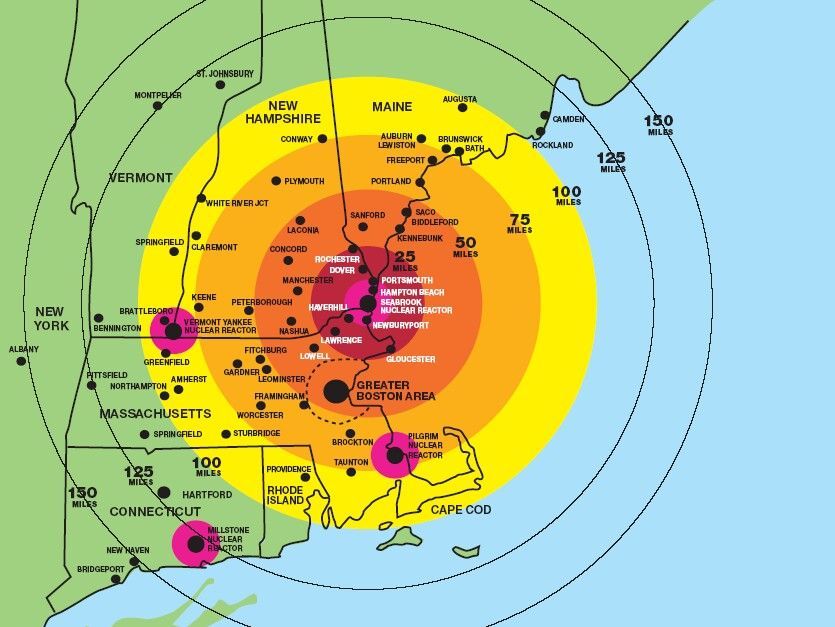C-10 Sees Cracks in the Nuclear Regulatory Commission Response to its Petition on Concrete Problems
- By Suzanne Worden, Journalist & C-10 Volunteer
- •
- 14 Apr, 2023
Uphill battles are still worth fighting, especially when the stakes are high and science and reason are on your side.

The problem
is degraded concrete, structural damage caused when cement and water come into contact. Its scientific name is Akali-Silica Reaction (ASR)
and is more commonly known as “concrete cancer” because it forms inside the concrete and spreads. If the progression of this cancer is not properly tracked, then the structure of the concrete can fail.

The place is Seabrook Station Nuclear Power Plant in Seabrook, New Hampshire. Seabrook Station, which is owned and operated by NextEra Energy of Juno Beach, Florida, is located 48 miles north of Boston, the state of Massachusetts’ largest city. 170,000 residents from 17 towns in New Hampshire and 6 towns in Massachusetts live within the power plant’s 10-mile radius, known as the Plume Exposure Emergency Planning Zone (EPZ), a zone where people may be harmed if exposed to higher-than-normal levels of radiation. Over 1 million people live within 50 miles of the plant, known as the Ingestion Exposure Pathway, where radiation may contaminate water, food and livestock. Degraded concrete was first discovered at Seabrook Station in 2010. Seabrook is the only U.S. nuclear plant known to be suffering from ASR concrete degradation. But, any other nuclear plant whose concrete contains the same types of aggregates is at risk of developing this same problem.

The responsibility for ensuring that the plant’s owners are checking the affected concrete, and all safety measures and protocols at Seabrook Station, is that of the Nuclear Regulatory Commission (NRC). C-10 Research & Education Foundation is a citizen-led nonprofit that conducts 24-hour-a-day monitoring of radiation in the air within the EPZ, and advocates for the safety of Seabrook Station nuclear power plant to protect public health and the environment in New Hampshire, Massachusetts, and beyond.
The response by the NRC is to inspect that plant employees are properly reviewing the progress of the cracked concrete, for the most severely cracked areas having to check every six months. It is in these NRC inspection reports where inspectors have repeatedly confirmed multiple violations of insufficient tracking of the progression of the cracks in the concrete, in some cases with complete negligence to take the required steps at all.
The petition: Last fall, C-10 submitted a petition to the NRC asking the federal regulatory agency to conduct a comprehensive investigation of Seabrook Station’s degraded concrete. C-10 pointed out that no one knows how widespread the cracks in the concrete structures are, and given the repetitive pattern of violations there, the NRC must strengthen consequences that will compel NextEra to do a better job monitoring the problem. C-10’s petition stated that in the last 18 months alone, the NRC cited 10 violations at the plant, two of which related to ASR.
The primary concern, according to C-10’s executive director, Sarah Abramson, “is that the ASR has weakened the plant's structures, and in the event of something like severe flooding or earthquake, there is no assurance that the concrete structures will hold. These structures are in place to keep radiation from leaking out into our communities."
According to John Ebel, author and an earthquake expert at the Weston Observatory at Boston College, “We saw on average a large quake that is 5.0 or greater in New England about every 60 years, the last one occurring in the Ossipee Mountains in 1940. So, we’re more than 20 years past the average.”

The denial: In March, the NRC’s Petition Review Board denied C-10’s petition, stating that even though there is a pattern of behavior at Seabrook Station leading to violations on the concrete issue, the errors were not willful, and, therefore, did not meet the criteria for further enforcement. Only the NRC Commission, the highest-ranking body in the agency consisting of five Commissioners, can overrule the petition’s denial. Though, such a thing has never occurred in any of the hundreds of petitions processed over the last 26 years.
The reaction by C-10 is firm. “The NRC’s position that every structure at Seabrook is currently able to perform its safety function, including those affected by ASR, is problematic,” says Abramson. “The agency discovers new areas of ASR in the Seabrook plant every year. So C-10, and any rational person, can draw the conclusion that there are many areas with crumbling concrete that we just haven't found yet. Thus, no one really knows the totality of the ASR damage to the concrete at Seabrook Station.”
The positive outcomes are many. C-10’s petition brought the critical issue of ASR concrete degradation at Seabrook Station to the best and the brightest technical experts at the NRC, the Nuclear Reactor (NRR) Regulation division, who have sway over how to respond to future violations. Additionally, the process of petitioning the NRC shed new light on the problem of ASR to other key audiences: the Commissioner and Inspector General of the NRC, members of congress and state legislators, and the media.
The future is ours to make. An ASR-specific inspection will take place at Seabrook in April, and C-10 will be watching. C-10 will review the results and report them to the appropriate government officials and agencies, the news media, and the public. In the meantime, C-10 stresses the importance of every household in the Seabrook area becoming better informed and prepared for every type of potential emergency that could occur.
ACCESS A COPY OF YOUR LOCAL RADIOLOGICAL EMERGENCY PLAN BROCHURE ONLINE: CLICK HERE FOR MA & CICK HERE FOR NH
Follow us



